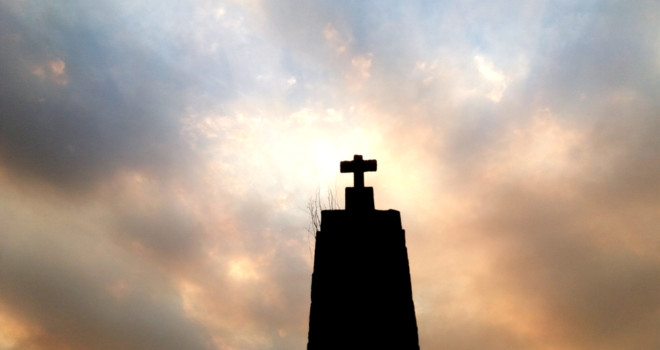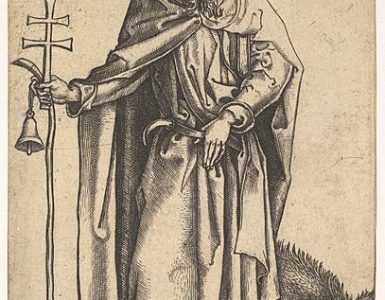During her own dark night of the soul, St. Therese
was confident that Jesus was with her, but also distressed that He appeared to
be asleep and hidden.
As she describes it,
[M]y soul was like a fragile skiff tossing without a pilot in a stormy sea. I knew that Jesus was there, asleep in my craft, but the night was too black for me to see Him. All was darkness. … Like Jesus during His agony in the Garden, I felt myself abandoned and there was no help for me on earth or in heaven. God had abandoned me (Story of a Soul, 61).
St. Therese’s experience is much like that of the
disciples in Mark 4
and Matthew 8.
Here is the version in Mark 4:
On that day, as evening drew on, he said to them, “Let us cross to the other side.”
Leaving the crowd, they took him with them in the boat just as he was. And other boats were with him. A violent squall came up and waves were breaking over the boat, so that it was already filling up. Jesus was in the stern, asleep on a cushion. They woke him and said to him, “Teacher, do you not care that we are perishing?” He woke up, rebuked the wind, and said to the sea, “Quiet! Be still!” The wind ceased and there was great calm. Then he asked them, “Why are you terrified? Do you not yet have faith?” They were filled with great awe and said to one another, “Who then is this whom even wind and sea obey?” (verses 35-41).
Teacher, do you
not care that we are perishing?
How often in the storms of our lives does it feel like Jesus is sleeping
through them? If even a great saint like St. Therese could feel this kind of
abandonment we should not be guilty if we experience something similar.
In the gospel story, things get very dire before
Jesus’ intervention. Waves are crashing over the boat and filling it up,
putting at risk of sinking soon. Even so, Jesus still sleeps. The disciples
must first cry out to Him for help. As Psalm 18:7 says, “In my distress I
called out: Lord! I cried out to my God.” And Psalm 106:44, “He heard their
cry; He took note of their distress.” Their cries—not the storm—wake Jesus up.
There are three things to note about how Jesus
responded. First, He has complete command of the circumstances. He does not
make the boat stronger, or cause the storm to merely ease off. He eliminates
the problem entirely, bringing a ‘great calm.’ Second, He transforms the
situation through His words. The power of the Word Incarnate is in His words.
He has no need to exert Himself. He does not, for example, hop into the
storm-tossed waters and drag the boat to shore.
Third, the transformation He effects is
total—extending from the external circumstances inward to the hearts of the
disciples. Jesus wanted the disciples to have faith that His presence would
suffice. He wanted them to have the confidence that He was aware of the
situation, even if He appeared to be sleeping. His sleep could be seen as a
test of their faith. It also was a confirmation of it: His mere presence should
have been comfort enough.
The greatest sleep Jesus experienced was the sleep of death. It is ultimately in the gospel account of this sleep that we should draw the greatest comfort. As the ancient homily for Holy Saturday puts it so well:
What is happening? Today there is a great silence over the earth, a great silence, and stillness, a great silence because the King sleeps; the earth was in terror and was still, because God slept in the flesh and raised up those who were sleeping from the ages. God has died in the flesh, and the underworld has trembled.
The homily suggests an explanation for this kind of
sleep: Jesus entered into the sleep of death so that He might be with those who
are asleep—the holy fathers of the Old Testament awaiting Him in limbo. Just as
God took on flesh to be among the living, so also He took on the sleep of death
that He might be with dead as well.
Jesus does not rouse us out of our spiritual slumber
by shaking us from the outside. He enters into Himself to awaken us from
within. As the homily says,
‘I command you: Awake, sleeper, I have not made you to be held a prisoner in the underworld. Arise from the dead; I am the life of the dead. Arise, O man, work of my hands, arise, you who were fashioned in my image. Rise, let us go hence; for you in me and I in you, together we are one undivided person.’
The darkness of Holy Saturday leads to the
brightness of Easter Sunday. The resurrection actually has its beginning not in
the tomb, but in the moment Jesus’ soul begins to ascend from the very depths
of hell. Even when Jesus appeared to be asleep, then, He was actually very
active—busy in hell proclaiming the victory of the cross, trampling the devil,
and rescuing the holy fathers in limbo.
If Jesus appears to be sometimes asleep to us, He
may be active and alive in ways that we cannot see. There is a kind of
fittingness and logic to this. The kind of help we often need requires work to
be done in areas that we cannot see—the hearts of estranged relatives, the
spirit of a child who is imprisoned in addiction, the minds and hearts of our
bosses, creditors, or bill collectors in who have the power to affect our
material wellbeing. If the help we most need is in the healing of a physical
ailment or mental illness then we certainly would not be able to see Jesus at
work.
This creates the capacity to be pleasantly
surprised. For every Holy Saturday we can look forward to being ‘surprised by
the joy’ of a resurrection.












